Karissa Hahn (Bridgeport, CT- 1992) is a visual artist who uses the mechanical devices of cinema to deconstruct former artifacts by physically transforming celluloid – an osmosis of digital manipulation & optical printing; creating a degraded aggregation into resurrection. her work often employs a series of format transfers to birth digitally-native effects on film and homogenized products which have been referred to as ‘spectra ephemera.’
She currently makes performative short super 8 films, hi8 video, and 16mm pieces.
Hahn has shown work around the globe in various micro-cinemas and institutions.

Francesca Pirillo: Did you attend school for art?
Karissa Hahn: I attended the California Institute of the Arts and received a Bachelors of Fine Arts degree in film and video.
F.P.: What influenced you as an artist growing up?
K.H.: The art program in my high school had been the first to diminish in a budget cut (and a brand new astro-turf football field appeared…) I wanted to make videos, to make anything really… and started making these weird little narratives in my friends basement. We would construct these sets and emulate what we would see our mothers watching on television, what action movies our siblings were viewing… think ‘James Bond’ meets ‘General Hospital.’ I was fortunate to have an english teacher who would screen my movies in his class, and that became my reason for showing up and for graduating.
I favored my time more at a circuit breaker factory where I had a workbench and toolkit and felt like an adult. I enjoyed the routine of testing circuit breakers all day and I believe I harbor that fascination still and use it when creating my inkjet pieces. I copy and paste each frame of a video onto a template in photoshop and then print it out through my inkjet printer. The routine is repetitive and meditative. The factory had a huge influence on my practice today.
I am trying to recall some moment of epiphany where I saw a painting in a museum or some sculpture an an exhibition, but I realize now that I did not have such exposure to fine art…. I do recall looking out the window while driving on the freeway and realizing one cannot keep their eyes from movement. If you fixate on one tree or sign you’ll crane your neck and soon it will be gone. The eyes have to keep up – like when working with individual frames of film, you can create each one meticulously, but while projected you cannot decipher one image from the former. I anticipate the action of projection.
Another influence may have been my fascination with ‘unseen barriers’ of situations. I was so perplexed that an action could cause such disruption with consequence and more-so; – that one has the ability to do it. The fact you can make an object from a seed of thought, that you can sculpt a figure from idea….with a camera you can create imagery just your own, hold the spool in your palm, and project it onto a screen or wall. I am interested in the things that we do when no one is asking us to do them.
This caustic medium can harbor such power. I feel that my works In Effluence accord; Emulsion and Effigy in Emulsion are most inspired by or trying to grasp that freeway feeling.
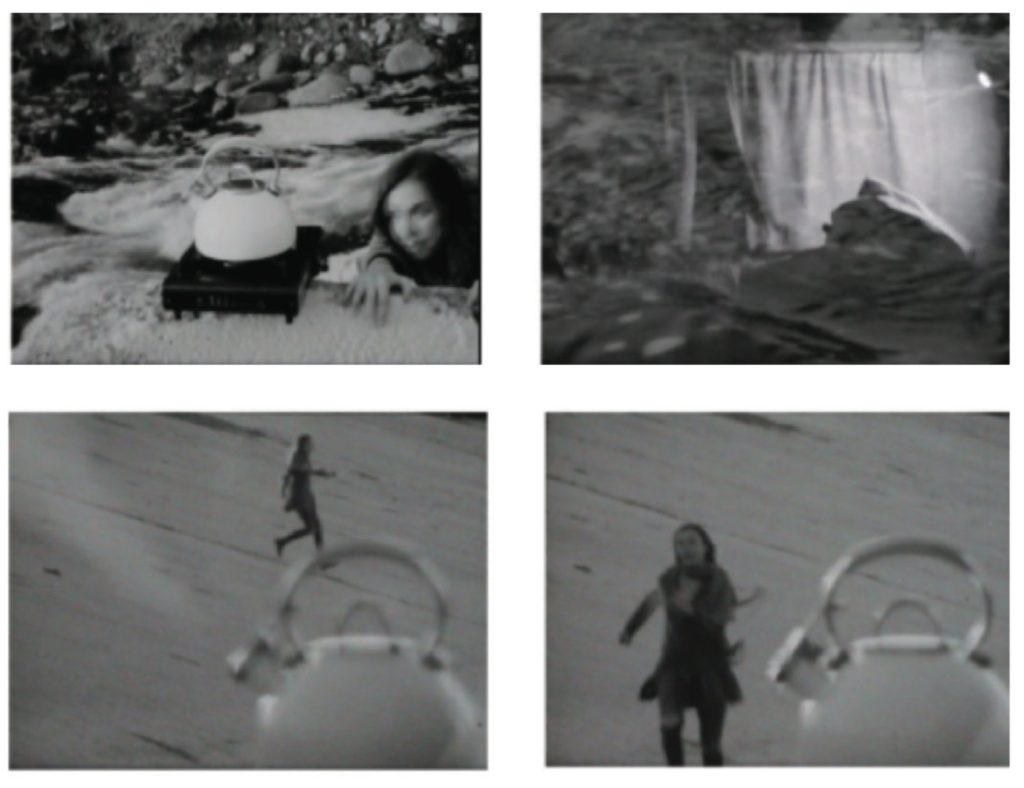
F.P.: How would you describe the way you approach your work? What is your working process like? Describe us your relationship between your subject and your medium.
K.H.: My medium is often film: super 8mm or 16mm, looping installation, and sometimes digital8 video.
I picked up this binder at a tag sale that has the words ‘Cosmetic Bootcamp’ inscribed on the front. I am not sure what this means but I like keeping all of my ideas in it. I also carry around a cassette tape recorder that I’ll talk to or record sounds on. I’ll return to these two characters for inspiration when approaching new work.
The subject of my films are often inspired by a gesture, a painting turned into sculptural pose. The medium of film is something that I enjoy reflecting the subject back to…. when shooting on film I want a connection to the medium…. so the subject often involves notions of the frame or process of filmmaking. I am currently involved in making digital-born images emerge onto celluloid. Photogrammetry is something I am trying to explore further, the reverse action of the inkjet process. I suppose the mixture of analog and digital is important in regards to the subject and medium. Setting up situations where analog and digital machines can converse conjures up moments where subject falls into medium or vice versa.
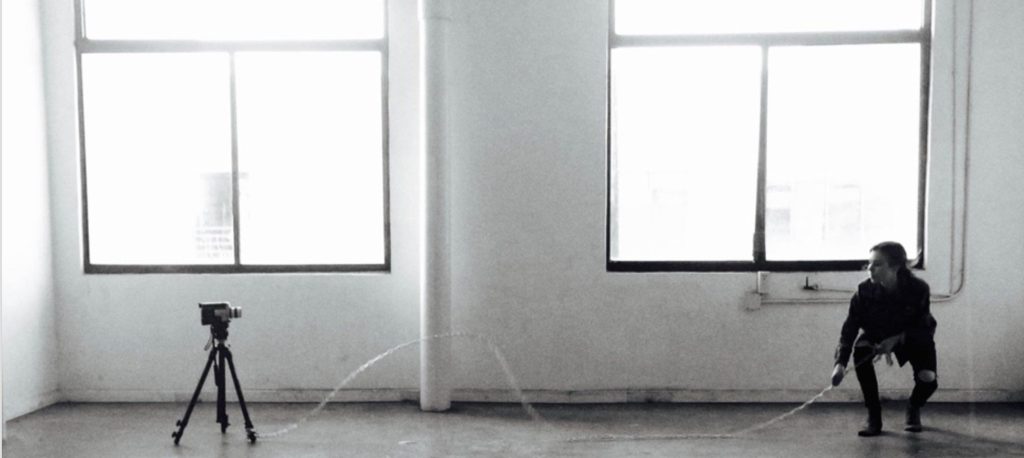
F.P.: Can you tell a bit about your work in detail? Which are the video that you’re most fond of and why?
K.H.: Startup. It was one of my first films, and one of the only pieces I made purely digital. It is a documentation of musicians in their bedrooms turning on their laptops and loading up their editing software before sitting down to make music.
Although I rarely ever work with or film other people, it is the foundation for a lot of where my work went to since. The mac logo is a recurring symbol in my inkjet pieces, and the structuralism is something that I have stuck to in both my performance pieces and optical printer films. This is funny to realize because my process in that piece is most far from what I do now. I spend a ton of time editing or splicing up a film or optically printing. This piece was just shot on video and put together in order and then it was done. Perhaps I am just saying this because it was easy….and now I work mostly with film so I am dealing with labs and equipment and various logistical and expensive dilemmas.
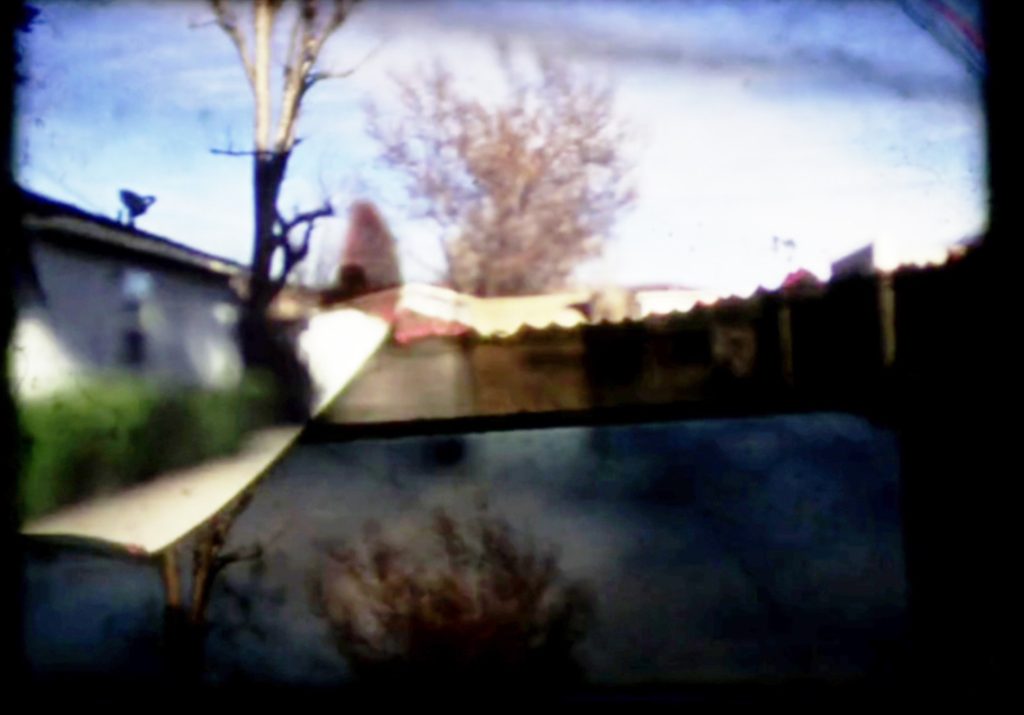
F.P.: Where do you find your biggest inspiration?
K.H.: Literature and the everyday. I always seem to have three or four people on my mind that change constantly, and they are often authors. Right now it is Carson McCullers, Russell Edson, D.M. Thomas, and Daniil Kharms. Jack Goldstein continues to inspire me….I’ll have a thought for a super short film and think it away….but then I’ll revisit his work and be reminded you can do something short and significant.
I go to this place called Phillips for 50 cent coffee and just watch people. I try to go places where I think I’ll find inspiration- yet often find it on my way to it – like seeing someone try to open a mailbox with a wrong set of keys, or I’ll notice the light hit some object at just the correct moment and remark it as cinematic. I suppose I’m most inspired by what happens when your not watching – moments when the eyes are fixated elsewhere and the mundanity continues on. Perhaps it is my current fixation with Russell Edson, but I enjoy the notion of phenomena and a certain collusion with absurdity.
For example: I will notice the colors of leaves change on a bush outside my home and think “oh, this woman named Linda came and touched each leaf changing its color yesterday so now they are different….that is why it is what it appears to be now.”
I would rather live and function within that absurd reality in order to come up with scenarios for film work.

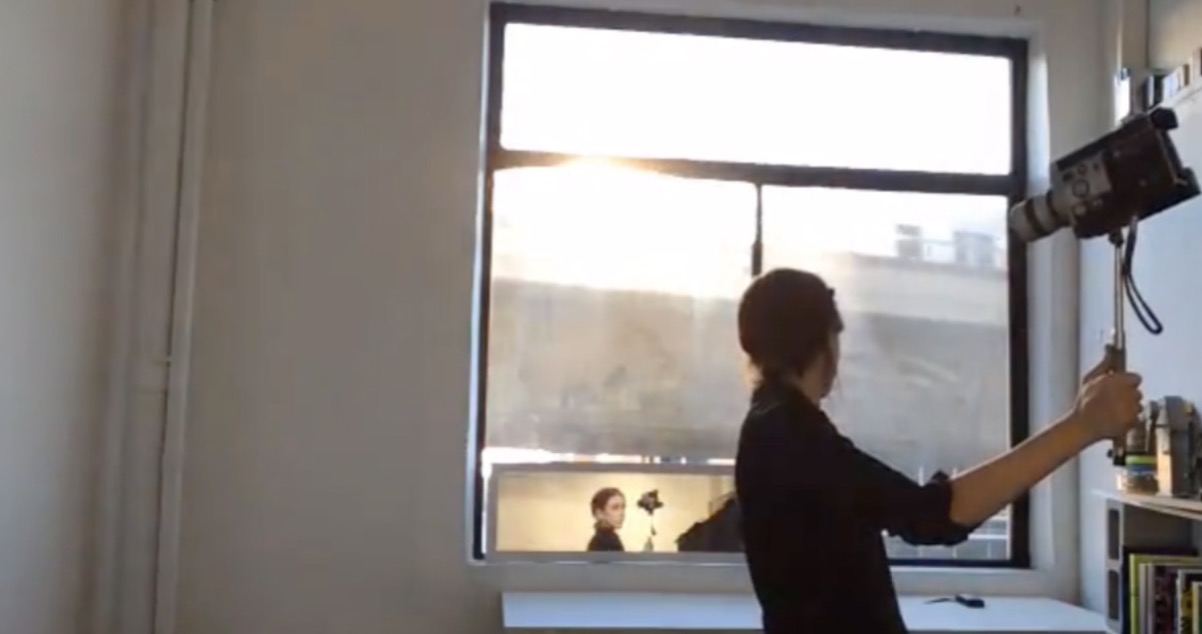
F.P.: You often use your portrait in your videos. What meaning has your image in your work?
K.H.: I sometimes look to painting for filmic inspiration as the single frame of portraiture often brings about notions off the canvas – the moments before or after the often male figure paints women… I try to give the subject some sort of life in the moment he fictionalized her existence.
My first 16mm piece, Before the Portrait, was a direct response John William Waterhouses’ painting, A Mermaid. I later returned to finding influence from painting with 1_ _ _ _1, where I tried to recreate the emotion or tension behind William- Adolphe Bouguereau’s A Young Girl Defending Herself Against Eros. Those cemented-extended arms which are usually depicted supple and wavering, backed by a face unconvincing and filled with volition. Something about her arms, locked elbows, chilled, contracted, and resolute. It was there that I imagined a chain extended (something harsh yet pliable) and drew the connection to making films in this current landscape. She lounges and emits coy, she arches her back and holds her arms stiffly out “defending” yet simultaneously playing hard to get. What were in his brushstrokes then as he extended those arms locked? The portrait is a nice starting point to create moving imagery as there is so much activity contained in stasis.
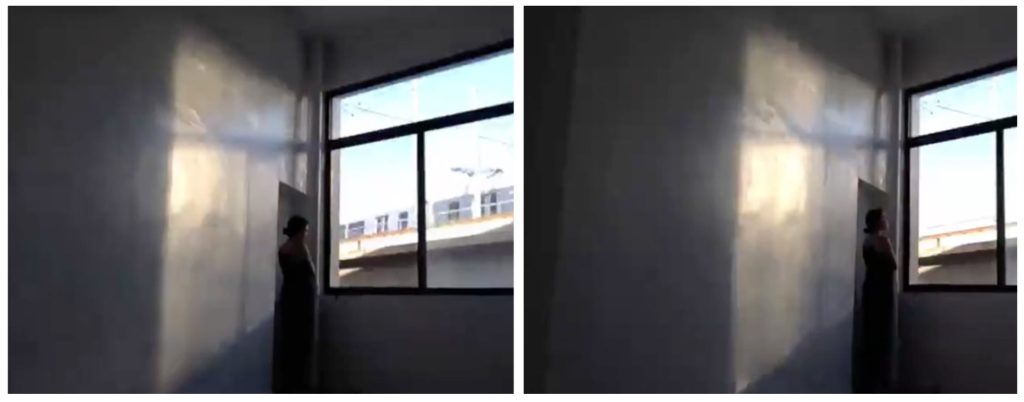
F.P.: What is your favorite experience as an artist?
K.H.: It is funny because I only really feel like an ‘artist’ or ‘filmmaker’ when at a festival or while at a gallery opening, and when I get into that scenario I find myself both petrified and amused by the whole system. When I’m home making a new piece I just feel like I am focusing on something that keeps me sane and fills the hours between work. I titled myself ‘visual artist’ on my webpage but I don’t truly know what that means. I often just introduce myself to people with whatever current random job I am working. Currently I work as a freelance videographer and find myself setting up lectures for visiting artists.
I guess whenever I get to speak publicly about film …. it’s like I am acting out someone else’s life or mimicking all the lectures I’ve filmed for work. I remember the gestures I’ve seen and emulate their voice in my public speaking. I guess its fun to play a role and slip into that life once in a while. I distress through – and though delight in this lovely confusion.
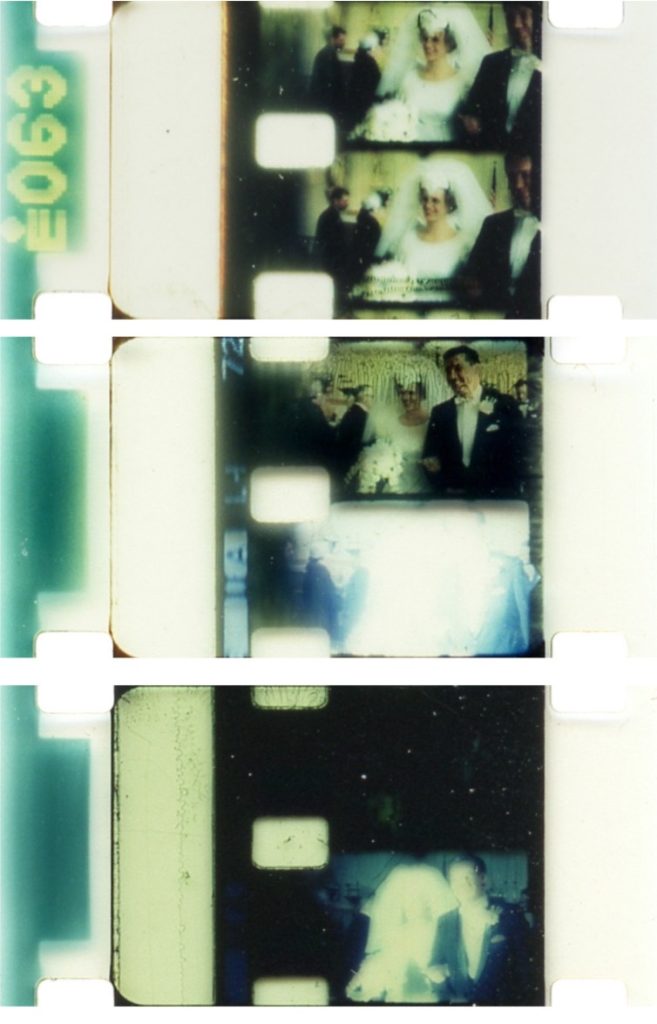
F.P.: What are you working on now, and what are your plans for the future?
K.H.: Every day I collect snippets of the news that I download and print out onto 16mm film. Since graduating from CalArts I have been working odd jobs – one of them being a videographer at an architectural institution. I treat this as my graduate education as I often come home inspired by architectural theory and apply it to my ways of thinking about the material of film. I hope to finish a book of prose poems by the end of the year. The future is all at once here and fleeting, it feels fragile.







